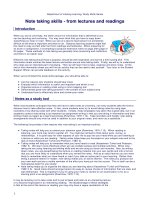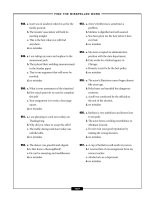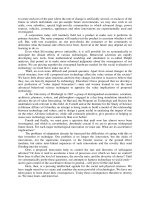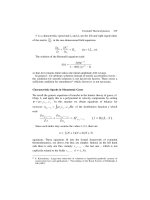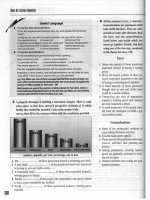Learning Express goof-proof Business Writing PHẦN 9 pdf
Bạn đang xem bản rút gọn của tài liệu. Xem và tải ngay bản đầy đủ của tài liệu tại đây (468.67 KB, 20 trang )
●
GOOF-PROOF SAMPLES
●
REPORTS
●
Sample Progress Report
PROGRESS REPORT
For the week of: 11/13/03–11/20/03
Submitted by: Robert Evans
Department: Facilities
Completed:
• repaired damage to roof from weekend’s ice storm (two days)
• replaced pipes under sink in men’s restroom
• repaired cracks in the wall in Conference Room C
• replaced lightbulbs in hallways
In Progress:
• Painting the cafeteria (progress is slow because I am limited to the hours I
can paint in there each day)
To Do (please rank in order of priority):
• install new window blinds in newly painted offices
• clean up branches and other debris from ice storm
• finish painting cafeteria
144
goof-proof
BUSINESS WRITING
●
Sample Incident Report
INCIDENT REPORT
Submitted by: Matthew Thomas
Date of Incident: 1/21/04
Position: Security Guard, 2nd shift Time of Incident: 17:18
Date of Report: 1/22/04 Location of Incident: Human
Resour
ces
Description of Incident:
On Monday, January 21, at 16:32, Mr. R. Turner, a former employee,
signed in at the security desk. He exchanged his driver’s license for a visi-
tor pass and put his destination down as Human Resources. At 17:18, I
received a call from Maria Louis, the assistant director of Human
Resources. She asked me to come to Human Resources immediately
because Mr. Turner refused to leave the office, which prevented her from
locking up.
I left Mark Davidson on duty at the desk and reached Human Resources
at approximately 17:21. When I arrived, Mr. Turner was sitting by the
receptionist’s desk. I told Mr. Turner that the office was closed and that
he had to leave. He said he would not leave until he saw John Francis,
the director of Human Resources.
Maria explained that Mr. Francis was not in that day, but he did not
believe her. She said Mr. Turner was waiting because he believed he
would catch Mr. Francis as he tried to leave. When I asked Mr. Turner if
her statement was true, he said yes.
I told him that he could no longer sit in the Human Resources office. If he
wished to wait, he could wait by the security desk, but he would be wait-
ing until tomorrow morning. Then I asked Mr. Turner to follow me, and
he did. After I escorted him to the security desk, I asked him if he wanted
to wait or have his ID back. He said he’d come back later, so I returned
his ID and he signed out at 17:30. After Mr. Turner left, Maria told me
that he had just been fired for insubordination.
145
Confusing the Types of Business Writing
●
Sample Program Evaluation Report in
Letter Form
Betty Hannaford
Company Researchers, Inc.
1220 West Side Highway
Smithville, Tennessee 37166
February 22, 2004
Samuel Kingston
President, New You Fitness
15 Shady Lane
Smithville, Tennessee 37166
Re: Program Evaluation
Dear Mr. Kingston:
We recently completed our evaluation of the group fitness programs
offered at your health club. This report summarizes our findings.
We evaluated four critical areas of your programs: diversity of offerings,
client satisfaction, instructor satisfaction, and cost/benefit. Group fitness,
as you know, scored highest in cost/benefit. A large percentage of your
gross profit comes directly from these classes. However, we did find room
for improvement in both diversity and instructor satisfaction. While your
clients are generally happy with the program, there was dissatisfaction
among your employees, which may be directly linked to the lack of diver-
sity in class offerings. I will address the findings in each area below; the
data we collected is attached.
The lack of diversity in class offerings was cited as a problem by 42% of
your instructors, and 38% of class participants. Instructors feel their tal-
ents could be better utilized by teaching new and different formats. For
example, two instructors are certified in Pilates, but no classes are cur-
rently offered. In addition, your two largest competitors, Ace Gym and
Body Works, both schedule spinning and Yoga classes throughout the
day. Both types of classes are very popular, and well attended. More
diverse offerings could expand your client base, and improve job satisfac-
tion rates for instructors.
146
goof-proof
BUSINESS WRITING
Diversity: Grade B
Client satisfaction is high, especially in light of the findings cited above.
81% of step aerobics students gave a “very good” rating to both instruc-
tors and class content. 76% of all group fitness participants gave a “very
good” rating in terms of the health and fitness benefits they receive
through attending classes. In addition, you enjoy a high percentage of
participation: Of the 2,482 members currently enrolled, 72% attend a
class at least once a week.
Client Satisfaction: Grade A
Instructor satisfaction could be improved in a number of areas. First,
many instructors wrote that they receive higher hourly wages at other
clubs in the area. Second, the scheduling of mandatory meetings on
weeknights was cited as a hardship. And third, a full 90% of instructors
feel they do not have the support of management when trying to obtain
continuing education credits. Other areas’ clubs do reimburse their
employees for attendance at continuing education classes and seminars.
Instructor Satisfaction: Grade C
As expected, the cost/benefit analysis of your group fitness programs
gave excellent results. Full numerical breakdowns are given in the
attached data sheets, but can be summarized as follows: For expendi-
tures of less than $75,000 per year, your program nets more than triple
that amount. It is by far the best revenue generator of your facility, and
every effort should be made to maintain and improve group fitness.
Cost/Benefit Analysis: Grade A
In closing, we find your group fitness program to be in good shape.
There are flaws, which can be corrected without making major changes
to your business model. If these corrections are implemented, you could
enjoy even greater revenue from this already highly profitable segment of
your business.
Sincerely,
Betty Hannaford
Company Researchers, Inc.
147
Confusing the Types of Business Writing
RULE #49: Thank You Letters Are Good Business
In order to keep your business relationships positive, make it a
habit to thank those who have helped you in any way. A well-writ-
ten, professional thank you letter isn’t just polite—it’s mandatory
for good business.
●
GOOF-PROOF IT!
●
When you write to thank someone, you are often reiterating
something you have already said in person or on the phone. By
sending a written communication, you’re showing that your sen-
timents are sincere enough for you to take the extra time and
effort to put it in writing.
Because a thank you letter is simply a specific sub-genre of the
business letter, the same formatting guidelines apply. Choose a
letter format to suit the formality level of the situation.
●
When You Must Write a Thank You Letter
• following an interview
• after a networking meeting
• in response to any business situation where you have been
given assistance
• after someone has purchased something from you
●
GOOF-PROOF CHECKLIST
●
THANK YOU LETTERS
✓
Literally say “thank you,” preferably in the first sentence.
✓ Use company letterhead if writing to a business associate.
If you know the person well, handwrite a thank you let-
ter on personal stationery.
✓ Never use your current company’s letterhead to commu-
nicate with a potential employer via the thank you letter.
Use your personal letterhead or handwrite a note.
148
goof-proof
BUSINESS WRITING
✓ Be specific about what you’re thanking the person for.
Use exact names, dates, places, and so on.
✓ Explain why you’re grateful; mention what the person
did or gave that deserves special thanks.
✓ Get to the point, and be brief.
✓ If you know the recipient well, your message should be
more personal.
✓ Send it quickly. While any message of thanks is better
than none, a thank you should be sent within a day.
●
GOOF-PROOF SAMPLES
●
THANK YOU LETTERS
Mary Ellen Bednar
Seating Unlimited
5699 Crawford Circle, Suite 801 Atlanta, GA 30456
TEL (404) 555-1238 FAX (404) 555-1239
www.seatingunlimited.com
September 15, 2003
Harold Ramsey
Ramsey Auto Company
345 Bedford Lane
Atlanta, GA 34567
Dear Mr. Ramsey,
Thank you for requesting information about the workbench stools. We are
proud of our wide selection and affordable pricing. Our most recent catalog
is enclosed. Should you wish to order from us, you can expect to receive
shipment within 2–4 weeks. Please let me know if you have any other ques-
tions or if I can be of further assistance. I look forward to your order.
Sincerely,
Mary Ellen Bednar
Vice President, Seating Unlimited
Enclosure.
149
Confusing the Types of Business Writing
Jackson Cressey
Auto Masters, Inc.
1650 Rockford Boulevard, San Diego CA 92182
TEL (858) 555-9889 FAX (858) 555-9899
www.automastersinc.com
November 10, 2003
Mr. Lee Singh and Mrs. Rita Singh
664 Warner Street
San Diego, CA 92182
Dear Mr. and Mrs. Singh,
On behalf of Auto Masters, Inc., I would like to thank you for purchasing
your new automobile at our downtown showroom this weekend. Our
goal is for you to be satisfied with your purchase for the life of your car,
and we will do all that we can to achieve your satisfaction.
We offer full servicing of your automobile under the warranty, and assure
you that our parts and labor rates are among the lowest in the county. In
addition, we would like to provide you with our VIP service free of charge
for one year. This service entitles you to complimentary oil changes every
3,000 miles, one complete detailing job, and preferred scheduling for any
required maintenance or repairs. Further details about our VIP service are
included in the attached brochure.
For your convenience, our customer service department will be happy to
set up a reminder service for routine maintenance of your vehicle. Once
established, you will receive a phone call or e-mail reminder one week
before a routine maintenance visit is required. To make scheduling more
simple, you may schedule appointments either via e-mail or telephone.
Please take the time to carefully read your owner’s manual and attached
information regarding routine maintenance and our VIP service. If you
have any questions, or are not completely satisfied with your new auto-
mobile, please call me directly at 555-9236. I will personally see that all
of your needs are quickly and thoroughly met. Auto Masters, Inc. is here
to serve you.
Sincerely,
Jackson Cressey
AutoMasters, Inc.
JC/kl
Enclosures.
150
goof-proof
BUSINESS WRITING
RULE #50: Be Precise When Writing Instructions or
Directions
It’s important to be clear and specific when writing instructions.
No matter what the instructions are for—applying for a loan,
installing software, or operating machinery—they must be
understood clearly by the reader.
●
GOOF-PROOF IT!
●
Leave nothing to chance when it comes to writing instructions
and directions. Don’t use words that can be misinterpreted. Keep
the language simple and straightforward. Break everything down
into simple steps, separated into a numbered or bulleted list. Even
if adults will use the instructions, they should be written and for-
matted so that a sixth grader could understand them.
●
Audience
The first step in writing a set of instructions or explaining proce-
dures should be familiar to you by now: Identify your audience.
Who will be reading these instructions or procedures? What do
these readers need to know, and why? At what level of techni-
cality or familiarity should you be writing to those readers?
Your instructions will be most successful if you determine your
audience’s “lowest common denominator” of knowledge. If all
readers know A, most know B, and only some know C, you can’t
write to the level of B or C—you must write to level A. If you
don’t, those readers who know A but don’t know B or C will not
be able to follow your directions.
It’s okay to risk wasting your readers’ time by telling them
things they may already know. Readers will skip over what’s
familiar, quickly separating new information from old. Never omit
anything that someone may not know.
151
Confusing the Types of Business Writing
●
Be Thorough
When writing instructions or directions, be as thorough as possi-
ble. With your lowest common denominator in mind, list and
explain every step of the process for someone at that level.
For example, imagine you got a new coffee machine in your
employee lounge and wanted to write directions for its use. Most
readers, you might assume, have a coffee machine at home, but
you can’t be sure. Perhaps there are one or two people who don’t.
Maybe some people only drink tea and have never used a coffee
machine. Thus, the lowest common denominator—the level to
which you must write—is made up of people who have never
used a coffee machine before. Don’t leave out any step in the
process. Your goal is to be thorough enough so that everyone who
reads them achieves the desired end result.
●
GOOF-PROOF CHECKLIST
●
INSTRUCTIONS AND DIRECTIONS
In addition to being written for the right audience, good instruc-
tions are also easy to follow. Here are a number of strategies to
help you write such directions:
✓ “Signpost” Your Readers—Let your readers know that
they’re doing things right. For example, “Take Route 1 to
Main Street” is not nearly as helpful as the following:
Take Route 1 five miles (approximately 10 minutes) to Main Street.
Look for the YMCA on your left; Y Street is the next intersection after
the YMCA. (If you pass the gas station, you have gone too far.)
✓ Use Lists—Lists are easier to follow than straight narra-
tive. Use separate paragraphs for each step, and, if possi-
ble, number or letter those paragraphs or set them off
with bullets. It’s also crucial to list the steps in chronolog-
ical order. Steps in a list that are out of order will con-
fuse, maybe even endanger, readers.
152
goof-proof
BUSINESS WRITING
✓ Use Specific Information—Use exact names and numbers
(times, distances, sizes, etc.) whenever possible. If you
are vague, your readers may have trouble understanding.
For example, “Submit your evaluations to Human
Resources” is not nearly as clear as “Submit your evalua-
tions to Deana Brown in Human Resources, Room 112.”
✓ Use Warnings—You can help your readers and make
your directions much safer by providing warnings or cau-
tions when appropriate. For example, “WARNING: If the
valve is not in the OFF position, pressure buildup may
cause the pipe to burst.”
●
GOOF-PROOF RULE OF THUMB
●
When writing instructions:
• Always make sure you thoroughly understand a procedure
before you attempt to write about it. If you don’t, you dras-
tically increase the likelihood that you will leave something
out or make a mistake in order.
• Get feedback. This is the best way to ensure that what you
have written does what it’s supposed to do.
• Follow your own instructions. Don’t do what you know how
to do; do only what you have written, exactly how you have
written it. Does it work? If not, revise. Then show your
instructions to someone else, preferably someone who has
never done the task you’re explaining. Are your instructions
clear? Easy to follow? Complete? See if your reader can per-
form the task without any trouble.
●
Formatting Guidelines for
Instructions and Directions
As with many other business writing formats, instructions gener-
ally have three parts: an introduction, a body, and a conclusion.
153
Confusing the Types of Business Writing
1. Introduction
All instructions should have some sort of introduction.
For a short set of instructions, all you really need is an
explanation of what the instructions are for: “How to
clear a paper jam” or “Procedure for clearing paper jams,”
for example.
If your instructions are more detailed, or if there’s a
particular reason why people should follow these
instructions, then an introduction should also tell readers
why the instructions are important. For example, you
might get a memo from payroll with the following
introduction:
Here are the procedures for completing and submitting time sheets.
It is essential that you fill out the sheets properly. Errors on these
sheets will mean errors on your paycheck. Be sure to fill out each
sheet completely. Incomplete sheets will not be processed.
This introduction offers important information that will
help readers follow the procedures more carefully.
Introductions for instructions may also:
• indicate how long the procedure will take
• describe what the finished product should look like
• mention a particularly important item that might be
overlooked or that needs to be emphasized (e.g., “Be
sure to pay particular attention to the deadlines listed
below.”)
• list any materials that the reader may need to follow
the instructions—forms, tools, etc.
2. Body
The body of a set of instructions lists the specific steps of
the procedure in chronological order. It can vary greatly
in length depending on how much information is needed
to follow the instructions.
3. Conclusion
A brief conclusion is often helpful for telling readers:
154
goof-proof
BUSINESS WRITING
• whom to call if they have any trouble
• what to expect next or from the results
• how to follow up, if necessary, on the procedure (e.g.,
“If you do not receive a reimbursement check within
three weeks, contact Ms. Miller in accounting at exten-
sion 345.”).
●
GOOF-PROOF SAMPLES
●
INSTRUCTIONS
Procedures for Tuition Reimbursement:
All full-time employees are eligible for tuition reimbursement for undergraduate
course work towards an AA, BA, or BS degree or graduate coursework that is
work-related. To receive reimbursement for tuition expenses, you must submit
a completed application form to Human Resources before you register
for class. In addition, you must earn a ‘B’ or better in the class in order to be
eligible for reimbursement. Detailed instructions follow:
1. Get a Tuition Reimbursement Application Form from Debbie in Human
Resources.
2. Fill out the form completely. Incomplete forms cannot be approved.
3. Have your supervisor sign the bottom of the form.
4. Make a copy of the completed form to keep for records. You will need
this form to pick up your reimbursement.
5. Submit the original completed application to Lorraine in Human
Resources. Human Resources must have this form on file before you reg-
ister for the course.
6. Register for and complete the course you were approved to take.
7. When you receive your grade report for the course, take it to Jennifer or
Andrew in payroll along with a copy of your completed application.
8. Request a Reimbursement Receipt form. Indicate on this form whether you
want to be reimbursed by separate check or have the amount added
directly to your payroll check. Give this form, your grade report, and your
application form to Jennifer or Andrew for processing. (You should make a
copy of all forms for your own records before submitting them to payroll.)
If you complete all of these steps, you should receive your reimbursement
check in the next payroll period. Please call Lorraine in Human Resources at
extension 4488 if you have any questions about the procedure.
155
Confusing the Types of Business Writing
To: All Teachers
From: Student Services
On September 8, our school will follow new guidelines regarding students’ tak-
ing of medications while school is in session. It is imperative that all school
employees both familiarize themselves with the new guidelines, and help par-
ents and students to understand and follow them. Attached are the new guide-
lines. Please read them, and then proceed as follows:
1. Retrieve copies of “Medication Guidelines for Students” handouts from
the office.
2. Distribute handouts on September 5 for students to take home and have
signed over the weekend.
3. On Monday, September 8, collect signed handout tear-off sheets, tally,
and return to the office, placing them in the special “Medication Guide-
lines” file.
4. Send home another handout with those students who did not return a
signed sheet on September 8.
5. On September 9, return any additional signed sheets, and make a list of
any outstanding sheets. Place the list in the principal’s mailbox before the
end of the school day.
Your cooperation in this important matter is greatly appreciated.
If you have any problems or questions, please bring them to the attention of
Mary King in Principal Wiley’s office (extension 16).
●
PUTTING IT ALL TOGETHER
●
Each type of written business communication has its own rules.
A letter shouldn’t look like a memo, nor should a report be mis-
taken for a proposal. The key to writing effectively at work is
understanding the composition and formatting differences
between the eight major workplace communications.
E-mails
• may be misinterpreted if not worded correctly; there is no
tone of voice, as in a phone call, to help convey your message
• feel informal, but should still be businesslike
• should be brief; if longer than a screen length, might be bet-
ter as a letter or memo
156
goof-proof
BUSINESS WRITING
• have a subject line that should be used to describe content
of e-mail in as few words as possible
Basic Business Letters
• are used for correspondence with other companies; rarely
used for internal communications
• document certain necessary information (who wrote to
whom, when, and about what)
• organize information neatly
• help readers find information quickly through a standard,
recognizable format
Memos
• are shorter, less formal, and less complicated in form than
letters
• are used for internal business communication
• should include headings if longer than one page
Agendas
• notify participants of meeting time, place, and topic(s)
• guide chairperson through meeting, helping maintain focus
and time control
• should be detailed, specific, logically sequenced, clearly
labeled, or numbered
Proposals
• formally attempt to convince someone to act on a project or
idea
• may take the form of a letter, memo, or other written busi-
ness communication
• clearly and specifically state intentions and explanation of
follow-through
• offer solutions to any potential problems before they’re
brought up
• provide step-by-step directions as to how to proceed once
accepted
157
Confusing the Types of Business Writing
158
goof-proof
BUSINESS WRITING
Reports
• follow same basic structure as business letter
• describe the outcome of an operation or a study
• benefit from time spent prewriting and organizing findings
and information
• are very structured, usually including all relevant statistics
and information
• end with conclusions and any necessary recommendations
• should summarize supporting data and include full infor-
mation or statistics as attachment or appendix
Thank You Letters
• say “thank you,” preferably in the first sentence
• are brief, succinct, and specific about what you’re thankful
for
• should be sent immediately
Instructions/Directions
• must be absolutely understood by the reader, and as thor-
ough as possible
• should be tested for effectiveness
• must be written to the lowest common denominator
RESOURCES
section
SEVEN
COMPUTER FORMATTING IN MICROSOFT WORD
●
Microsoft Word allows you to set everything from paragraph
indentation to the look (font style and size) of different types of
text.
Simply:
1. Click on “Format” on the toolbar.
2. Click on “Style.”
3. Find the “List” box.
4. Click on “All Styles.”
5. Scroll through the styles listed to find the item you wish to
change.
6. Highlight the item by clicking on it.
7. Click on “Modify.”
8. Click on “Format.”
9. Choose what you would like to change (font, paragraph,
etc.).
10. Make changes.
appendix
A
USING COMPUTER FORMATTING,
GRAMMAR, AND SPELLING TOOLS
11. Click on “OK.”
12. Click on “OK.”
13. Click on “Apply.”
●
COMPUTER GRAMMAR TOOLS
●
You should always use a grammar check program on your writ-
ing. Grammar check can find possible errors, draw your attention
to them, and suggest corrections. The settings on these programs
may be changed to check for only those elements that you spec-
ify; check for specific styles of writing, such as formal, standard,
casual, and technical; and check for errors as you type, or when
you are finished.
To modify the grammar check settings in Microsoft Word, open
a blank document and:
1. Click on “Tools” on the toolbar at the top.
2. Select “Options.”
3. Click on the “Spelling and Grammar” tab.
4. Click on “Settings” in the lower grammar section.
5. Read the list of options, and select those you want gram-
mar check to look for.
6. Click on “OK.”
Although you should always use grammar check, you should
not always trust it. Grammar programs make mistakes, both by
missing errors, and by flagging “errors” that are actually correct.
In fact, there have been a number of studies done comparing the
effectiveness of various programs, and they perform about the
same (fair to poor).
The first problem, missing errors, is illustrated by the following
examples. A grammar check on the following sentence did pick
up the subject/verb agreement error (I is), but did not notice the
participle error (I studying).
“I is ready to take the exam after I studying my notes and the textbook.”
162
goof-proof
BUSINESS WRITING
Similarly, the punctuation problems in the following sentence
were not flagged.
“The recipe, calls for fifteen ingredients and, takes too long to prepare.”
When grammar check does highlight an error, be aware that it
may in fact be correct. But if your knowledge of grammar is lim-
ited, you won’t know whether to accept grammar check’s cor-
rections. To further complicate matters, you may be offered more
than one possible correction, and will be asked to choose
between them. Unless you are familiar enough with the specific
problem, this may be no more than a guess on your part.
While there have been improvements in computer grammar
checking, nothing is more effective than a careful review of your
writing after using the program. Our list of proofreading tips on
page 100 offers a number of great suggestions.
●
USING COMPUTER SPELL CHECKERS
●
You should always use your computer’s spell check function
because it’s fast and easy, and it catches many spelling mistakes
and typos. But you should also be aware of spell check’s two
most important limitations, and use other reliable methods to
catch the errors that spell check cannot.
●
Non-Word versus Real-Word Errors
Although your computer spell checker will flag strings of let-
ters that do not make real words, it will not flag spelling errors or
typos that do result in real words. For example, spell check will
alert you if you mistakenly type gorila instead of gorilla or becase
instead of because. But it won’t alert you if you mean to type and
but type an instead because an is a legitimate word; it’s just not
the word you meant to type. Likewise, spell check won’t flag
errors that result from commonly confused words, such as typing
to when you meant to type too or two.
163
Using Computer Formatting, Grammar and Spelling Tools




